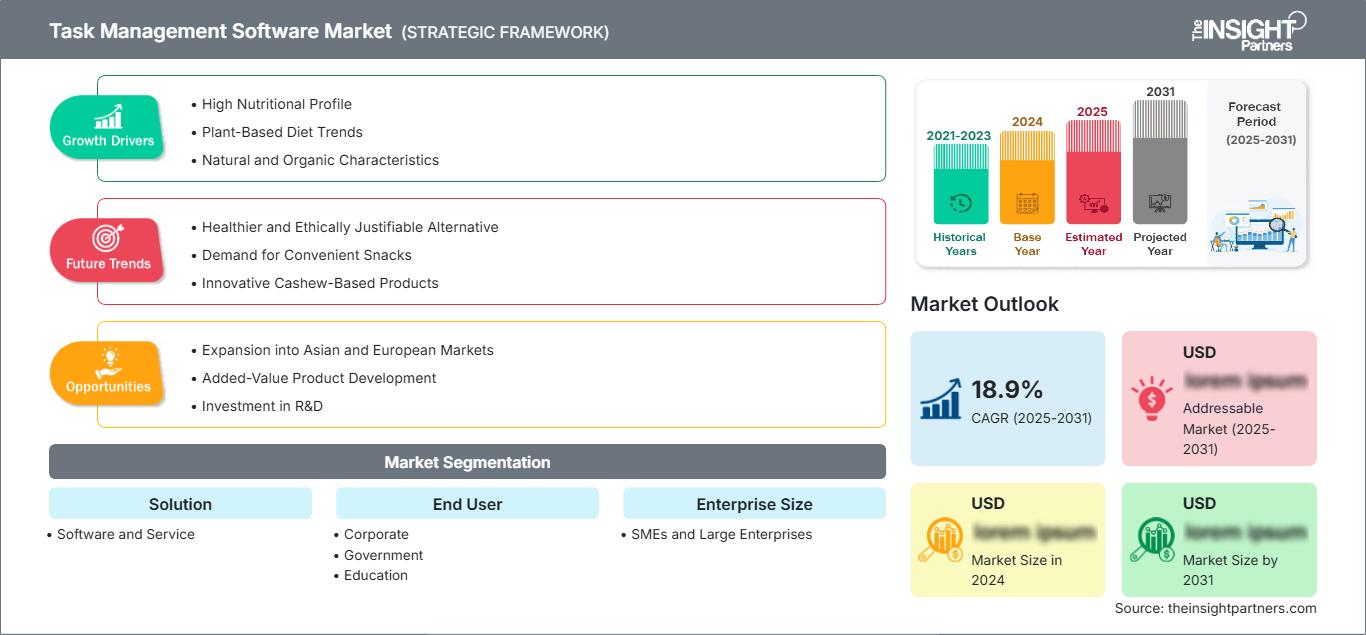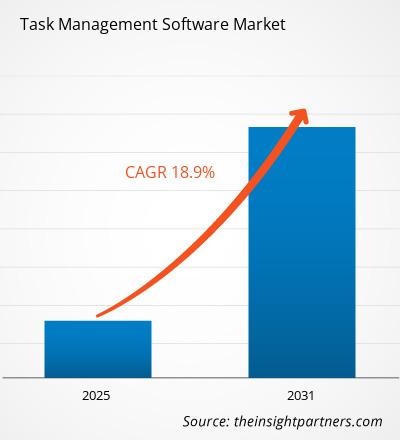Der Markt für Task-Management-Software wird voraussichtlich zwischen 2025 und 2031 eine durchschnittliche jährliche Wachstumsrate (CAGR) von 18,9 % verzeichnen, wobei die Marktgröße von XX Millionen US-Dollar im Jahr 2024 auf XX Millionen US-Dollar im Jahr 2031 anwachsen wird.
Der Marktforschungsbericht zu Task-Management-Software ist nach Lösungen in die folgenden Untersegmente unterteilt: Software und Service. Der Bericht bietet außerdem eine Analyse basierend auf Endbenutzern, d. h. Unternehmen, Behörden, Bildung, Medien und Unterhaltung. Der Markt ist auch nach Unternehmensgröße segmentiert, einschließlich KMU und Großunternehmen. Die Marktbewertung wird für die obige Segmentanalyse in US-Dollar angegeben.
Zweck des Berichts
Der Bericht „Task-Management-Software-Markt“ von The Insight Partners zielt darauf ab, die aktuelle Situation und das zukünftige Wachstum sowie die wichtigsten treibenden Faktoren, Herausforderungen und Chancen zu beschreiben. Dadurch erhalten verschiedene Geschäftsinteressenten Einblicke, beispielsweise:
- Technologieanbieter/-hersteller: Um die sich entwickelnde Marktdynamik zu verstehen und die potenziellen Wachstumschancen zu kennen, sodass sie fundierte strategische Entscheidungen treffen können.
- Investoren: Um eine umfassende Trendanalyse hinsichtlich der Marktwachstumsrate, der finanziellen Marktprognosen und der Chancen entlang der Wertschöpfungskette durchzuführen.
- Regulierungsbehörden: Um Richtlinien und Überwachungsaktivitäten auf dem Markt zu regulieren, mit dem Ziel, Missbrauch zu minimieren, das Vertrauen der Investoren zu wahren und die Integrität und Stabilität des Marktes aufrechtzuerhalten.
Lösung zur Marktsegmentierung von Aufgabenverwaltungssoftware
- Software und Service
Endbenutzer
- Unternehmen
- Behörden
- Bildung
- Medien und Unterhaltung
Unternehmensgröße
- KMU und Großunternehmen
Geografie
- Nordamerika
- Europa
- Asien-Pazifik
- Süd- und Mittelamerika
- Naher Osten und Afrika
Sie erhalten kostenlos Anpassungen an jedem Bericht, einschließlich Teilen dieses Berichts oder einer Analyse auf Länderebene, eines Excel-Datenpakets sowie tolle Angebote und Rabatte für Start-ups und Universitäten.
Markt für Aufgabenverwaltungssoftware: Strategische Einblicke

- Holen Sie sich die wichtigsten Markttrends aus diesem Bericht.Dieses KOSTENLOSE Beispiel umfasst Datenanalysen, die von Markttrends bis hin zu Schätzungen und Prognosen reichen.
Wachstumstreiber für den Markt für Aufgabenverwaltungssoftware
- Hoher Nährwert: Cashewnüsse, die reich an gesunden Fetten, Proteinen, essentiellen Vitaminen und Mineralstoffen sind, sorgen für eine hohe Nachfrage auf dem Weltmarkt.
- Trends bei pflanzlicher Ernährung: Cashewnüsse werden zu einer vielseitigen Alternative in Milch- und Fleischprodukten und entsprechen der wachsenden Vorliebe für pflanzliche Ernährung und Lebensweise.
- Natürliche und biologische Eigenschaften: Die natürliche und biologische Anziehungskraft von Cashewnüssen bietet zahlreiche Möglichkeiten für den Einsatz in verschiedenen Lebensmitteln, darunter Süßwaren, Backwaren, Milchalternativen und Nussbutter.
- Nachfrage nach gesunden und nachhaltigen Lebensmitteln: Die Vorliebe der Verbraucher für gesündere und nachhaltigere Lebensmitteloptionen sorgt für eine starke Dynamik des Cashewnussmarktes in den kommenden Jahren.
Zukünftige Trends im Markt für Aufgabenverwaltungssoftware
- Gesündere und ethisch vertretbare Alternative: Cashewnüsse gelten als gesünderer und ethischerer Ersatz für traditionelle Nahrungsquellen und sind daher für bewusste Verbraucher attraktiver.
- Nachfrage nach praktischen Snacks: Die zunehmende Vorliebe für praktische Snacks für unterwegs wird zum Wachstum des Cashewnussmarktes als tragbare, nahrhafte Wahl beitragen.
- Innovative Produkte auf Cashewbasis: Neue Produktentwicklungen wie Cashewmilch, Cashewkäse und Cashewbutter werden den Markt erweitern und mehr Verbraucher anziehen.
- Fortschritte in der Verarbeitungstechnologie: Verbesserungen der Verarbeitungstechniken werden die Qualität, Haltbarkeit und Verfügbarkeit von Cashewnüssen steigern und so ihr Marktpotenzial weiter erhöhen.
Marktchancen für Aufgabenverwaltungssoftware
- Expansion in asiatische und europäische Märkte: Die Ausweitung des Cashewnussgeschäfts auf asiatische und europäische Märkte, wo das Gesundheitsbewusstsein der Verbraucher in Bezug auf Snacks schnell zunimmt, birgt großes Wachstumspotenzial.
- Produktentwicklung mit Mehrwert: Die Diversifizierung auf Nussbutter, Milch und Käse wird eine breitere Verbraucherbasis ansprechen, verschiedene Altersgruppen erreichen und die Marktpräsenz erhöhen.
- Investitionen in Forschung und Entwicklung: Die Konzentration auf Forschung und Entwicklung zur Verbesserung der Verarbeitungstechniken, der Produktqualität und der Erforschung neuer Anwendungen wird die Marktposition weiter stärken und Innovationen fördern.
- Partnerschaften mit Einzelhändlern und Lebensmitteldienstleistern: Strategische Allianzen mit Einzelhändlern und Lebensmitteldienstleistern verbessern die Sichtbarkeit und Verfügbarkeit von Produkten und sorgen so für eine höhere Nachfrage und größere Marktanteile.
Regionale Einblicke in den Markt für Aufgabenverwaltungssoftware
Die Analysten von The Insight Partners haben die regionalen Trends und Faktoren, die den Markt für Task-Management-Software im Prognosezeitraum beeinflussen, ausführlich erläutert. In diesem Abschnitt werden auch die Marktsegmente und die geografische Lage in Nordamerika, Europa, dem asiatisch-pazifischen Raum, dem Nahen Osten und Afrika sowie Süd- und Mittelamerika erörtert.
Umfang des Marktberichts zur Aufgabenverwaltungssoftware
| Berichtsattribut | Einzelheiten |
|---|---|
| Marktgröße in 2024 | US$ XX million |
| Marktgröße nach 2031 | US$ XX Million |
| Globale CAGR (2025 - 2031) | 18.9% |
| Historische Daten | 2021-2023 |
| Prognosezeitraum | 2025-2031 |
| Abgedeckte Segmente |
By Lösung
|
| Abgedeckte Regionen und Länder | Nordamerika
|
| Marktführer und wichtige Unternehmensprofile |
|
Dichte der Marktteilnehmer für Aufgabenverwaltungssoftware: Verständnis ihrer Auswirkungen auf die Geschäftsdynamik
Der Markt für Task-Management-Software wächst rasant. Dies wird durch die steigende Nachfrage der Endnutzer aufgrund veränderter Verbraucherpräferenzen, technologischer Fortschritte und eines stärkeren Bewusstseins für die Produktvorteile vorangetrieben. Mit der steigenden Nachfrage erweitern Unternehmen ihr Angebot, entwickeln Innovationen, um den Bedürfnissen der Verbraucher gerecht zu werden, und nutzen neue Trends, was das Marktwachstum weiter ankurbelt.

- Holen Sie sich die Markt für Aufgabenverwaltungssoftware Übersicht der wichtigsten Akteure
Wichtige Verkaufsargumente
- Umfassende Abdeckung: Der Bericht analysiert umfassend Produkte, Dienstleistungen, Typen und Endnutzer des Marktes für Aufgabenmanagement-Software und bietet einen ganzheitlichen Überblick.
- Expertenanalyse: Der Bericht basiert auf dem umfassenden Verständnis von Branchenexperten und Analysten.
- Aktuelle Informationen: Der Bericht gewährleistet Geschäftsrelevanz durch die Berichterstattung über aktuelle Informationen und Datentrends.
- Anpassungsoptionen: Dieser Bericht kann an spezifische Kundenanforderungen angepasst werden und passt sich optimal an die Geschäftsstrategien an.
Der Forschungsbericht zum Markt für Aufgabenmanagement-Software kann daher dazu beitragen, die Branchensituation und die Wachstumsaussichten zu entschlüsseln und zu verstehen. Obwohl es einige berechtigte Bedenken geben mag, überwiegen die Vorteile dieses Berichts tendenziell die Nachteile.
- Historische Analyse (2 Jahre), Basisjahr, Prognose (7 Jahre) mit CAGR
- PEST- und SWOT-Analyse
- Marktgröße Wert/Volumen – Global, Regional, Land
- Branchen- und Wettbewerbslandschaft
- Excel-Datensatz
Aktuelle Berichte
Verwandte Berichte
Erfahrungsberichte
Grund zum Kauf
- Fundierte Entscheidungsfindung
- Marktdynamik verstehen
- Wettbewerbsanalyse
- Kundeneinblicke
- Marktprognosen
- Risikominimierung
- Strategische Planung
- Investitionsbegründung
- Identifizierung neuer Märkte
- Verbesserung von Marketingstrategien
- Steigerung der Betriebseffizienz
- Anpassung an regulatorische Trends




















 Kostenlose Probe anfordern für - Markt für Aufgabenverwaltungssoftware
Kostenlose Probe anfordern für - Markt für Aufgabenverwaltungssoftware